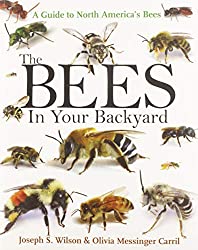Bumble Bees of North America An Identification Guide
By Paul
Williams, Robbin Thorp, Leif Richardson & Sheila Colla
At last!
A very comprehensive guide to the bumble bees of North America, which, as the book states, has:
“attempted to make the process of identifying bumble bees as straightforward as (the authors) can, stripping away technical language where possible and presenting a system that specialists and beginners alike should be able to use”.
There are several elements to this book. It’s more than a series of pictures to help you ID bumble bees.
Book review
Here is a
description of what it contains, and why I like it.
Firstly,
there is the identification guide part.
Each of the 46 bumble bee species found north of Mexico, is
covered.
There are at least 2 photographs for each species, often three, and sometimes four.
On top of this, there is a very handy graphical representation of the identified variations in the different colour segments, by queen, worker and male, to enable you to be more precise in your I.D. of the species. This feature, I think, will be especially useful for the student, or very serious enthusiast.
There is a
graph (histogram), showing the seasonal activity patterns of queens, workers
and males. Again, this information can
help you to I.D. bumble bees. For
example, you will initially see queens, then as the queen establishes its colony, workers are produced who will take over the foraging to feed the
colony. Then later, new queens will emerge. Males appear later in the
season.
Added to this, the text for each species describes particular features to look out for, such as hair texture, hairs on the legs (tibia), face length and so on.
There is a map, indicating the known geographical distribution. This is a useful tool, because if you identify a bumble bee that apparently is not known to be distributed where you found it, either:
- You
can check again to see whether you have the correct identification
- If you are still certain, take a photograph and send this information to Xerces, and the authors of the book. It would be interesting for them to know whether the ranges of species are shifting, and you may not be the only one to have noted the shift.
There is also a brief written description of range,
habitat, food plants, particular behaviours, such as nesting preference, and
finally whether the bumble bee is prone to any parasites.
To help further with identification, the guide contains a chapter about mimicry, showing photographs of insects that appear to mimic bumble bees, and useful notes about distinguishing bumble bees from other insects.
For the serious student, there is an identification key to male and female bumble bees, with photographs of particular features, such as eyes, tibia hair, antennae etc.
What Else Do I Like About Bumble Bees Of North America?
On top of the information described, there are chapters covering distribution and diversity, interaction with plants, and an interesting bumble bee forage guide by ecoregion. This covers important forage plants for north American bumble bees in the boreal forests, tundra/taiga, north west forested mountains, marine west coast forest, eastern temperate forest, great plains, North American deserts and southern semi arid highlands and Mediterranean California.
There is some information about attracting bumble bees, and a brief explanation for their declines.
Finally, there is a useful glossary at rear of the book.
Despite all the information, this book is concise, user friendly, and even handy to carry!
Who Wrote The
Book?
The lead author is Dr Paul H. Williams, a research entomologist at the Natural History Museum in London.
Robbin Thorp is emeritus professor of entomology at UC Davis, and other co-authors are Leif L. Richardson, a doctoral candidate in the Department of Ecology and Evolutionary Biology at Dartmouth College; and Sheila R. Colla, postdoctoral fellow at the Natural Sciences and Engineering Research Council of Canada and a project leader at Wildlife Preservation Canada.
Note:
There is only one thing I would like to add concerning advice on capture and killing bumble bees for purposes of observation. The book makes the point that it should be possible to observe some bumble bee species without killing them, but there then follows a few short paragraphs about capturing and killing specimens, preserving and pinning them. I have seen such advice in other guide books, and wish to add that I discourage the practice of capturing and killing bees, no matter how apparently humane the methods are reported to be.
If you are an amateur wishing to observe bumble bees (or other bee species), I strongly recommend you take the time to observe them whilst they are alive.
If you are very keen to see close ups for the purpose of learning more about identification, visit your museum, and perhaps arrange an appointment with the relevant member of staff. You may find they are willing to spend time with you, discussing the trickier elements of identifying bumble bees, or perhaps they are planning a course. Killing bees just to have a closer look at them seems wrong to me, especially given the difficulties they face.
I still recommend the book, however, because it will first and foremost be a very helpful guide for any one interested in bumble bees.
Bumble Bees of North America is available from Amazon
BuzzAboutBees.net is a member of the Amazon Associates Program.
As an Amazon Associate I earn from qualifying purchases if you click on a link from my website to an Amazon website page. I only recommend books and goods I myself like. Further information, see: Advertising And Affiliates Disclosure.
Meadowland
by
John Lewis-Stempel
A review of this beautiful nature diary




